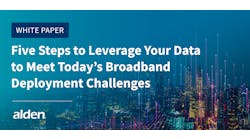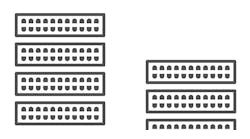Latest from Data Centers
Maximizing Potential Beneath Our Feet: The New Edge of Dark Fiber Investment
How increased demand for data infrastructure nationwide is straining market capacity and fueling a “new” edge.
By now, we all understand that data has become the driving force behind innovation. No matter the industry, location, customer, or provider, companies are using data to improve efficiency, fuel growth, and discover new opportunities. Over the past decade, we've seen a significant surge in data-intensive applications that have put a strain on our networks. Because of this, the once-efficient infrastructure is now struggling to handle the data demand. Businesses and individuals are facing frustrating delays and connectivity issues.
As we look ahead, it’s also clear that in addition to managing and adapting to yesterday’s growing data consumption, we must also prepare for the continued growth fueled by emerging trends such as AI and machine learning. According to IDC's forecast, new data creation is projected to grow at a compound annual growth rate (CAGR) of 23%, resulting in approximately 175ZB of data creation by 2025. This clear indication highlights the need for creative solutions that address the needs of a new era.
Preparing for Tomorrow's Data Demands
Amidst the explosive surge in data consumption, a phenomenon known as the “edge” in data infrastructure emerged. Traditionally, we’ve envisioned the “edge” in geographical terms, picturing the need to expand and move further from major metros to establish data centers closer to users.
Fueled by AI, data analytics, remote work, and big data overall, the demand for data continues to skyrocket, and the concept of the "edge" has taken on new meaning. It might once again be time to challenge our conventional understanding of the edge because the edge is no longer about distance and reaching further out; it's about capacity and maximizing the potential right beneath our feet—within our urban centers and data hubs.
As data demands grow, and supply is pushed to its limits, businesses are confronted with a critical decision: how to prepare for the data demands of tomorrow. This decision isn’t just another operational consideration; it is a long-term strategy move, much like purchasing an insurance policy. Instead of safeguarding against unforeseen disasters, however, this insurance policy ensures that organizations are prepared for the ever-expanding data landscape. The urgency of this decision comes into sharp focus when we consider the current supply-demand dynamics surrounding dark fiber and conduit. And maybe, nowhere else on the planet is this more evident than in Data Center Alley.
Data Center Alley’s Infrastructure Advantage
Northern Virginia’s position as a global powerhouse in data structure infrastructure is no secret, and has been highlighted, once again, in Cushman & Wakefield's 2023 Global Data Center Market Comparison. This extensive annual study covers 63 global markets and over 1,600 data centers and offers a comprehensive analysis covering 13 distinct categories, including fiber connectivity, market size, and cloud availability. Northern Virginia has been a recurring front-runner in the study and retained its top spot again this year. With its substantial market size, boasting over 2,600 megawatts of commissioned power, and impressively low vacancy rates of below 1%, Northern Virginia reaffirms its status as a global leader in data center infrastructure.
Infrastructure Strategy for Tomorrow’s Demands
Virginia's ascent as a data center powerhouse was driven by early and extensive investments in fiber optics. The state's appeal was initially tied to its proximity to Washington, D.C., and the subsequent arrival of the Metropolitan Area Exchange, East, which attracted firms and spurred fiber network growth. This strategic groundwork reduced latency, making it an attractive hub for data centers. Virginia further incentivized the industry with sales tax exemptions and leveraged its skilled workforce, low energy costs, and streamlined development processes.
Continued infrastructure investments, such as subsea cables like MAREA and BRUSA connecting Virginia to Europe and South America, further bolstered its status. Today, Northern Virginia's data center market surpasses the combined size of the next five largest U.S. markets. The industry's significance to the global economy is underscored by claims that around 70% of the world's Internet traffic traverses Data Center Alley each day.
It's clear Data Center Alley holds a crucial role as one of the world's vital data hubs, and it's important to maximize its potential to ensure it remains indispensable to businesses in the future. This isn't just about pushing the boundaries of expansion; it's also about strengthening the core right beneath our feet. How can we achieve this? By planning for the ever-growing data demands of today and tomorrow, which could mean securing a surplus of dark fiber and conduit infrastructure.
By proactively making these investments, businesses can position themselves to meet the escalating data needs of today and tomorrow. This strategic approach not only supports their growth but also reinforces their resilience in the face of evolving digital challenges. It's about future-proofing operations and preparing for the data-driven world that lies ahead.
Future-Proofing: Dark Fiber Rising
Forward-thinking carriers, data centers, cloud providers, and enterprises recognize the need to strategize for the future by bolstering their fiber capacity in high-demand regions such as Data Center Alley. And one way of staying ahead of the curve lies in acquiring dark fiber and conduit now, essentially securing an insurance policy against tomorrow’s inevitable surge in data requirements. This foresight-driven approach involves obtaining unused, unlit fiber optic cables that are strategically positioned within conduits for future activation.
To address densifying data demands, many organizations are turning to high-count dark fiber solutions. The appeal of high-count dark fiber lies in its capacity to accommodate an extensive volume of data traffic, making it an ideal choice for long-term scalability. By seizing the opportunity to acquire these assets now, organizations position themselves for a smoother and more cost-effective transition when they eventually decide to "light up" this dark fiber, bringing it into active service.
Additionally, the acquisition of dark fiber and conduit infrastructure not only future-proofs operations but also enhances overall network resilience and flexibility. As the world becomes increasingly reliant on data-intensive applications, cloud computing, and emerging technologies like IoT and 5G, having the necessary fiber infrastructure in place ensures organizations can adapt swiftly and efficiently to meet evolving connectivity demands.
“It might once again be time to challenge our conventional understanding of the edge because the edge is no longer about distance and reaching further out; it's about capacity and maximizing the potential right beneath our feet—within our urban centers and data hubs.”
Choosing the Right Infrastructure Provider
Equally important to location is having the right infrastructure provider. A specialized dark fiber provider familiar with the region offers unique advantages. They possess invaluable insights into the latest advancements in network infrastructure. These newer networks are essential due to their lower likelihood of technical problems, faster speeds, and overall reliability. They not only strengthen your current operations but also ensure that your network is ready to meet future demands.
A strategically located, high-capacity, purpose-built network, such as DF&I’s newly constructed, all-underground Express Connect® dark fiber and conduit system, offers several benefits. It facilitates access and on-net interconnection to the precise locations, data centers, clouds, and carriers your business requires. It also equips your company with the scalability necessary for future growth.
Data Infrastructure as a Strategic Investment
In an evolving digital landscape, businesses must approach their data infrastructure strategy with the same level of precision they use when selecting an insurance policy. It's not just about resource allocation; it's a strategic decision aimed at securing a competitive edge.
Partnering with specialized providers with extensive experience in building high-capacity dark fiber networks ensures a robust, scalable, and future-ready data infrastructure. So, as your business navigates the digital terrain, remember that investing in data infrastructure is more than a strategic move; it's an investment in a future where data is the currency of success. The time to act is now, as those who secure their fiber assets today will be well prepared to meet the data demands of tomorrow.

Scott Bergs | Chief Executive Officer, DF&I
Scott Bergs is the Chief Executive Officer of DF&I. He has over 30 years of experience in executive management, operations, sales and marketing, customer support, legal and regulatory support, fundraising, and M&A strategy and execution. Scott’s industry background spans data centers, fiber networks, wireless network operators, ISPs, and other critical communications infrastructure.
Prior to joining DF&I, Scott served as CEO of communications infrastructure provider Vivacity Networks. Prior to Vivacity, he was the Co-Founder and CEO of Neutral Path Communications, a dark fiber and infrastructure provider that was successfully sold to Zayo Group. Scott’s experience includes other senior executive positions at Revol Wireless, Alltel Communications, Midwest Wireless, PriceCellular-CellularOne, and MobileComm – a Bellsouth Company. Earlier in his career, he worked as a technology attorney with nationally recognized law firm Stinson LLP, advising communications, technology, and software companies on a variety of commercial and legal matters.
Scott received a BS in Business Administration from Minnesota State University and later earned his JD from Mitchell Hamline School of Law in St. Paul Minnesota.
For more information, visit DF&I at https://darkfiberinfra.com/express-connect/. Follow DF&I and Scott, respectively, on LinkedIn: https://www.linkedin.com/company/df-i/ and https://www.linkedin.com/in/scott-bergs-8a40a75/.




